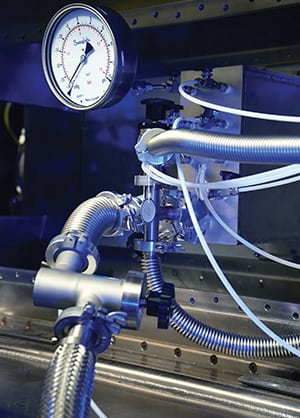Scrubbing Coal Plant NOx Emissions with Electron Beams
An unnamed power company and the U.S. Naval Research Laboratory (NRL) have partnered to test a concept proven to work at a small scale that applies pulsed electron beam technology to slash coal plant nitric oxide and nitrogen dioxide (NOx) emissions.
The concept (Figure 3) essentially involves directing electron beams from a cathode into the exhaust of a coal plant and firing them in pulses to break apart the NOx bonds. When the bonds between the nitrogen and oxygen atoms are ruptured, explains Dr. John Sethian, the plasma physicist leading the project at NRL, “They naturally want to combine into just pure nitrogen and pure oxygen, because those are the most stable substances.”
A small-scale test involving a mixture of just nitrogen and NOx was successful. Real flue gas may have nitrogen, carbon dioxide (CO2), oxygen, water vapor, sulfur oxide (SOx), and particulates—depending on the type of coal used, he noted. “CO2 wasn’t a problem, but the oxygen threw us for a loop,” said Sethian, who believes the problem is now solved, but that others may arise before the team is ready to demonstrate the electron beam at a power plant. “I think, if we lick the remaining physics and chemistry challenges, we could probably have something ready to field in about two years.”
The electron beam system, dubbed Electra, was originally developed as part of NRL’s laser fusion program. As Sethian explained, if the electrons are fired into a krypton fluoride gas (instead of flue gas), they excite the molecules in the gas and produce a smooth laser beam that makes them ideal for driving a fusion reaction in a pea-sized pellet. But with breakthroughs in nuclear fusion still elusive, NRL is using the cutting-edge research for more achievable uses like the NOx concept. The lab is working on further developing the pulsed electron beam under a cooperative research agreement with Zerronox Corp., a company that specializes in systems to remove nitrous oxides from exhaust gases.
If successful, the technology could prove to be a boon for the power sector, which is subject to strict NOx regulations by the Environmental Protection Agency. According to the agency’s Clean Air Markets Division, emissions of SO2 and NOx from the power sector declined to their lowest level since the passage of the Clean Air Act Amendments of 1990. That decline has been mainly attributed to increasing retrofits by coal power plants with flue gas desulfurization, selective catalytic reduction (SCR), selective noncatalytic reduction, or low-NOx burners. The switch to lower-sulfur coal and cheaper natural gas has also played a major role in the decline of SO2 and NOx declines.
If NRL’s technology works, it could provide another NOx emission technology option that would be about 10% to 20% of the cost of a catalytic scrubber for energy, and “we don’t have any byproducts,” said Sethian.
—Sonal Patel, associate editor
